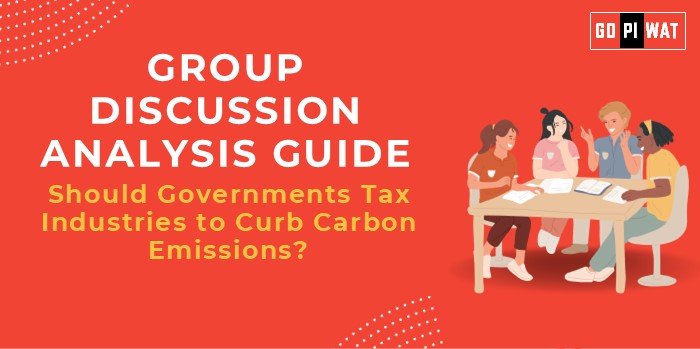📋 Group Discussion (GD) Analysis Guide
Should Governments Tax Industries to Curb Carbon Emissions?
🌍 Introduction to the Topic
- 🔥 Opening Context: Climate change, one of the most pressing global challenges, has reignited debates on whether taxation policies can effectively deter industrial emissions. Countries like Sweden and Canada have shown success with carbon taxes, but the approach remains contentious globally.
- 📖 Topic Background: The idea of taxing polluting industries aims to internalize the environmental costs of their actions. It has gained momentum following the Paris Agreement, which emphasizes carbon reduction targets. However, there are concerns about economic repercussions and fairness.
📊 Quick Facts and Key Statistics
- 🌍 Global Emissions by Industries: Industrial processes contribute ~20% of global CO2 emissions (IEA, 2023).
- 💰 Carbon Pricing Adoption: Over 60 countries have implemented some form of carbon pricing, covering ~23% of global emissions.
- 📈 Economic Impact: Sweden’s carbon tax ($140/ton CO2) reduced emissions by 25% while growing its GDP by 78% since 1991.
- 🌱 Developing Nations’ Share: Emerging economies are responsible for ~70% of future emission growth (World Bank).
🌍 Stakeholders and Their Roles
- 🏛️ Governments: Enact taxation policies, monitor compliance, and invest revenue in green initiatives.
- 🏭 Industries: Adapt operations to meet tax requirements, invest in sustainable technology.
- 👥 Citizens: Bear indirect costs through higher prices, demand eco-friendly goods.
- 🌐 International Organizations: Provide frameworks (e.g., UNFCCC) and facilitate knowledge sharing.
🏆 Achievements and Challenges
Achievements:
- 📉 Emission Reductions: European countries implementing carbon taxes report notable declines in industrial emissions.
- 🔄 Revenue Utilization: Funds are often reinvested in renewable energy, public transport, or energy efficiency.
- 💡 Technological Advancements: Taxes incentivize R&D in green technologies.
Challenges:
- 💸 Economic Burden: High taxes could lead to job losses or higher consumer prices.
- 🌍 Global Competition: Countries with lax regulations attract industries, leading to carbon leakage.
- ⚖️ Equity Concerns: Impacts developing nations disproportionately.
🌍 Global Comparisons:
- 🇸🇪 Success: Sweden’s carbon tax is hailed as a model.
- 🇺🇸 Challenges: The U.S. has faced opposition due to economic and political concerns.
📖 Case Studies:
- 🇨🇦 Canada: Carbon tax has seen mixed reviews but reduced emissions by 3% in sectors covered.
- 🇮🇳 India: Energy efficiency measures in industries under the PAT scheme have reduced CO2 emissions by ~105 million tons.
💬 Structured Arguments for Discussion
- ✅ Supporting Stance: “Taxing industries is essential to curb emissions and fund green development effectively.”
- ❌ Opposing Stance: “Higher taxes risk economic slowdown and unfairly penalize developing economies.”
- ⚖️ Balanced Perspective: “While taxation is effective, it must be part of a broader strategy including innovation and global cooperation.”
🗣️ Effective Discussion Approaches
Opening Approaches:
- 📊 Start with a compelling statistic about industrial emissions.
- 📖 Use a case study like Sweden’s carbon tax success.
Counter-Argument Handling:
- 💡 For economic burden: Highlight potential for reinvestment in green jobs.
- 🌍 For fairness issues: Emphasize global fund mechanisms to support poorer nations.
📊 Strategic Analysis of Strengths and Weaknesses
- 💪 Strengths: Proven emission reduction, innovation stimulation, revenue for sustainability.
- ❌ Weaknesses: Economic impact on vulnerable sectors, global competitiveness risks.
- 🌟 Opportunities: International green partnerships, climate leadership potential.
- ⚠️ Threats: Resistance from industries, global inequalities.
🎓 Connecting with B-School Applications
- 🌐 Real-World Applications: Policy frameworks, CSR strategies, or sustainable finance models.
- 🎯 Sample Interview Questions:
- “How can industries balance profitability and sustainability under higher taxes?”
- “Discuss the impact of carbon pricing on global trade relations.”
- 📘 Insights for B-School Students:
- Explore policy frameworks for green innovation.
- Analyze case studies of successful taxation models.


